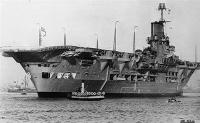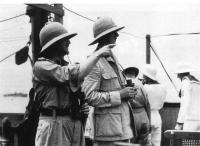Written By: Sam Ghaleb Ridgecrest, Calif.

HMS Ark Royal

British Gen. Sir Edward Spears and Free French Gen. Charles de Gaulle aboard ship en route to Dakar.
On 10 June 1940, the French Army's resistance against the German Blitzkrieg, in the West, was coming to an end. Prime Minister Winston Churchill of Britain took several trips to France to encourage it to continue fighting and not to give up. The French, however, at this point were basically begging the British to release them from this obligation. With both the French Army and Air Force totally shattered under the weight of the German Blitzkrieg, the French Navy remained almost intact. This gave the French government a trump card in case of negotiations with the Germans over the future of France. At this point Admiral Jean Darlan, Commander of the French Fleet, told Prime Minister Churchill that the Fleet would be sunk before it was surrendered to the Germans.
But that was not to happen. Although Admiral Darlan was strong in his commitment to prevent the Germans from seizing a single French warship, Churchill was not convinced. Losing Britain's last fighting ally in the war is one thing, but allowing that ally's modern and large fleet to fall into the hands of the Germans was something that kept the British wondering about the fate of the fleet and what to do next.
On 22 June, France and Germany signed an Armistice. Part of that agreement was that the French could keep their fleet. Hitler treaded lightly concerning the warships and did not push for full ownership. He feared that such demand would inspire the French to keep on fighting. However, Hitler's concerns were not known to the British at the time.
After the Armistice, the French fleet came under the control of the Vichy Government which controlled the southern part of France and the French colonies overseas. The fleet was divided between the French base of Toulon on the Mediterranean and the overseas bases of Casablanca in Morocco, Mers-el-Kebir in Algeria, Dakar in French West Africa, while some units were kept in Vichy controlled Syria and Lebanon. But that was not enough for the British. On 1 July, Churchill was finally able to get the backing of the War Cabinet to sink the French warships that were based in the French colonies if they would not be surrendered.
On 3 July, the British surrounded the French fleet at the port of Mers-el-Kebir, right outside Oran, Algeria. Churchill's message was clear: sail to Britain, sail to the USA, or scuttle your ships in the next six hours. At first, the French refused to speak to negotiators. Two hours later, the French showed the British an order they had received from Admiral Darlan instructing them to sail the ships to the USA if the Germans broke the armistice and demanded the ships. Irregardless, Admiral Sir James Somerville, commander of the British Task Force assigned to destroy the French fleet, attacked. In less than ten minutes, 1,297 French soldiers were dead and three battleships were sunk. One battleship and five destroyers managed to escape.
On 9 September 1940, three French light cruisers - Montcalm, Gloire and George-Leygues - left Toulon and passed through the strait of Gibraltar without being challenged by the British. As a result, the local British commander, Admiral Sir Dudley North, was relieved of his command, and was never to be heard from again. The flotilla refueled at Casablanca and continued to Dakar, arriving on 14 September.
By the autumn of 1940 the situation for Britain had improved somewhat. The Battle of Britain had been won and the danger of German invasion of the British Isles had receded. The newly formed Free French forces were anxious to get into action as soon as possible. It was decided to test the loyalty of the French population in Colonial French West Africa. A decision was made to secure a strategically placed port on the West Coast of Africa by landing a force of Free French under General Charles de Gaulle at Dakar, Senegal. On 23 September, the Anglo-French force approached Dakar in the hope that the local population could be persuaded to turn against the Vichy Government. After Mers-el-Kebir, this was an unrealistic hope. The British Fleet then bombarded the town and engaged the French warships at Dakar from September 23-25th before breaking off the action.
The attack on Dakar was code named Operation Menace. Because of Dakar's strategic importance to the North and South Atlantic shipping routes, a Free French expedition was embarked to acquire the port for Allied use. The Free French troops led by General de Gaulle were carried on ships escorted and supported by units of the Home Fleet and Force H under the command of Vice-Adm John Cunningham. They included the battleships HMS Barham and HMS Resolution, the carrier HMS Ark Royal, three heavy cruisers, 2 light cruisers and 10 destroyers and other ships that carried the British landing force and 2400 Free French troops.
On 18 September, the three French cruisers that arrived on the 14th left Dakar intending to go to Libreville in Gabon. On the way they were intercepted by British naval units, including the heavy cruiser HMAS Australia. The Montcalm and George-Leygues outran the British ships and returned to Dakar, where they helped to defend the port against British and Free French attack. The Gloire, slowed by mechanical problems was unable to escape and was ordered back to Casablanca.
The Vichy naval forces at Dakar came under the command of Pierre Francois Boisson. These forces included the unfinished battleship Richelieu, two cruisers, Montcalm and George-Leygues, four destroyers and several submarines. There were also air units that included American made Glenn Martin bombers and Curtiss Hawk 75A fighters.
The attack on Dakar began on Monday the 23rd September 1940. French aircraft flew off from the carrier HMS Ark Royal and landed at Ouakam aerodrome within Dakar. Propaganda leaflets were dropped over the town by Fleet Air Arm aircraft. De Gaulle's representatives entered Dakar Harbor in a motor boat flying the French flag, and a white flag of peace - but were fired upon - and nothing further was heard from them. The next step was taken. The Allied force, which included British and the 2400 Free French troops, was landed. After a short but sharp action, the landing was repulsed by French troops loyal to the Vichy Government. This led de Gaulle to declare that he did not want to shed the blood of Frenchmen for Frenchmen. The action now settled into a duel between the Royal Navy battleships and heavy cruisers, and the French battleship Richelieu, French cruisers, destroyers and submarines. The guns of the French fort at Dakar were also involved in bombarding Royal Navy warships. As a result, a French submarine was sunk and a large destroyer disabled and the Royal Navy heavy cruiser HMS Cumberland was heavily damaged.
On 24 September, there was a gunnery duel between the French battleship Richelieu and the British battleship HMS Barham. The Barham was hit twice by the shore batteries manned by ratings from the Richelieu. In the engagement the Richelieu was struck by two 15-inch shells from Barham, but the damage was not serious. During these engagements, the French made use of an ingenious device to distinguish the spotting of their shell bursts. Each salvo was marked by a certain color: Richelieu used yellow; the forts white; and the cruisers green and red.
The action continued on 25 September. As the Royal Navy force of cruisers and battleships began to withdraw, the battleship HMS Resolution was struck by a French torpedo, and took on a heavy list to port. In the meantime French Vichy Martin bombers attacked the stricken ship and dropped large bombs. French fighters were also busy; one Curtiss Hawk fighter shot down a Royal Navy observation plane. The attacking force now left the Dakar area, with the battleship HMS Barham taking HMS Resolution under tow with the heavy cruiser HMAS Australia supporting them as they withdrew at a slow speed.
The attack on Dakar became a debacle for the Royal Navy. Two battleships were damaged, one of them seriously, two heavy cruisers were heavily damaged and two destroyers also seriously damaged. Aircraft were also shot down and the landing force was repulsed.
In retaliation for the attack on Dakar, the French bombed the British base at Gibraltar. On 24 September about 50 aircraft flew from French bases in North Africa and dropped 150 bombs while on 25 September about 100 aircraft dropped 300 bombs on the harbor and dockyards. Most of the bombs missed. However, some damage and a few casualties were caused. As a result of the Royal Navy action, Dakar and French West Africa remained in Vichy hands.
Dakar would revert back to the Allied side in November 1942, after Operation Torch - the Allied landings in North Africa. By that time the Germans occupied the rest of France and the Vichy Government collapsed.
With Dakar in Allied hands, it was used to organize convoys, and support U-boat hunting groups in the battle of the Atlantic.
NEXT WEEK: THE TRI-PARTITE PACT
«Go back to the previous page.

